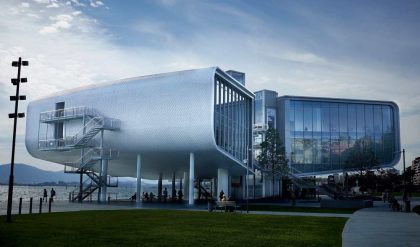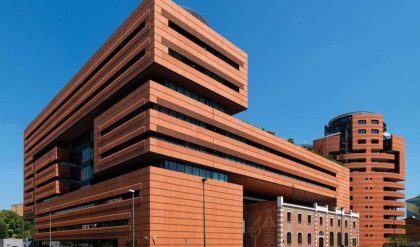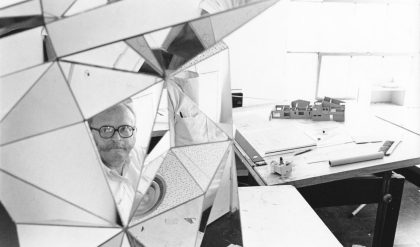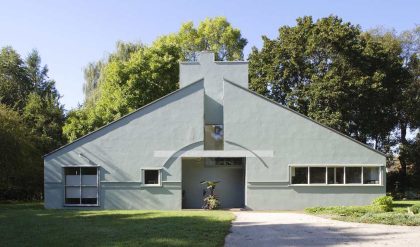Topics and lines of inquiry into philosophy of architecture have engaged one or more of the preceding movements and illustrate the breadth, intellectual richness, and relevance of the field. Consider a few of these.
a. Architecture and Representation
The question raised early in this article, one that invites further inquiry and positions philosophy of architecture as propositional, “What is architecture?” begs consideration of the relations between the material substances and physical properties of buildings and their representation through various media. The key issue is how the materials, tools and techniques of architecture partly or wholly determine what architecture is or can be. Is designing and visualising buildings the same as thinking about their ethical or other value? Does visualising an ideal building or urban form contribute to its meaning or form part of an architectural experience?
The historical development, prevalence and the popular appeal of wide-ranging media, including conventional design and construction drawings and models, new digital media and even film, have shaped architectural discourse and underscored forms of professional expertise. Ways of representing or producing images of buildings, like plan-metric (two-dimensional), orthogonal or perspective drawings and, more recently, computer renderings of complex building forms, have supported various design and construction practices. These have also encouraged speculation on the capacity of architecture to embody ideas and entail a distinctive way of conceptualising the world. (For instance, Winters 2011 writes on the critical attitude cultivated by “paper”—delineated, but unbuilt or unbuildable—architecture.) This is a tendency that borrows reasoning from art history, studies of iconology and meaning and influential books like Erwin Panofsky’s Perspective as Symbolic Form (1927). The Euclidean character of visual space has been questioned and by some accounts, superseded by new visual regimes that challenge conventional understanding of relations between the architectural object and the viewing/inhabiting subject. Even building diagrams, popularly caricatured as the architect’s calling card when scribbled on dinner table napkins and taken to indicate a unique kind of self-reflection, can raise questions about architecture’s intertwined practical and philosophical aspects.
Studies of architectural media have also prompted philosophical reflection on architecture as affording understanding of transcendental values and existential meaning. For some architectural theorists, for instance, plans and drawings are representations of a second order, seemingly distant from all sense of time and place. For others, new digital media allow not only for the easy visualisation, rapid prototyping and construction of novel architectural forms, but also provide insight into the human condition in an era of globalisation and rapid technological change. On the one hand, issues raised by Walter Benjamin’s much cited essay in “The Work of Art in the Age of Mechanical Reproduction” (1935) run parallel to concerns for architecture given the representation and mass-reproduction of building forms and their contribution to dominant global culture. On the other, the dynamism of fluid building forms, so-called architectural “blobs” and forms inspired by Deleuze’s interest in “the fold” or “folded” spaces (1988), promises unheralded opportunities for self-invention and social renewal.
The utility of “representation” as a trans-historical category of critical analysis (in architectural theory and cultural studies, generally) is accompanied and in some cases countered by philosophical reflection on time, temporality, and transience whereby two- and three-dimensional images of buildings possess only limited value in themselves. In architecture, these themes are evident in arguments for the essential timelessness and fundamental intelligibility of Classicism (Porphyrios 1982) that renders it more than a style, or studies describing the physical characteristics of building materials and emphasizing the meaningfulness of weathering (Mostafavi and Leatherbarrow 1993). Building age and the register of weather, organic and human factors on timber, stone and other materials can be valorised as providing the necessary conditions for Heidegger’s concept and state of “being-in-the-world” whereby the alienation of human subjects from the material world of objects is overcome. These relatively recent studies are worth comparing to 18th and early 19th century aesthetic treatises on ruination, the sublime, and picturesque, though their provenance is not wholly attributable to them.
Conversely, on some accounts, architecture comes into its own when distanced from strict demands for functionality, conventional delineation, and commonly-held meanings (Benedikt 1991; Harbison 1991). Visionary schemes set in “cyberspace,” so-called “virtual” and “unbuilt” (also “paper”) architecture are described and valued for their intellectual content, provocative appeal, and their potential to liberate communities from what is construed as the deadweight of the past, historical building styles, and the conservatism of much architectural heritage. From this follow another set of issues discussed in the literature. One is whether or not an architectural work or proposition is complete when drawings are finished, independent of the design’s construction and prior to the project’s occupation and evaluation. If wholly propositional or paper architecture possesses a kind of creative integrity, this raises questions about the necessary contribution (or otherwise) of the project’s sites and settings (physical and performative) to the design process. Is the architect first and foremost a visionary, rather than merely a technician? If so, how can communities come to understand, share, and assess the architect’s largely utopian mission?
b. Architectural Value and Heritage
Questions concerning the integrity of a work of architecture and the autonomy of the architect as a particular kind of expert or visionary correspond to those asked about other kinds of artworks. Can a work of virtual architecture, a painter’s cartoon or unfinished symphony make a lasting contribution to an artistic canon, or must they invariably be “read” as secondary in importance, interpreted according to existing representational or technical (that is, social) norms? Is unbuilt architecture best left as it is, unrealised, or an unfinished masterpiece best left incomplete, thereby allowing audiences—and posterity—the freedom to fill in the missing pieces? If the latter proposition is correct, then is the meaning of an artwork invariably a social construct? Does the architect, artist, or composer ever have a lasting claim (in term of its meaning) over their work, as they intended it to be?
These questions highlight philosophical issues concerning a creative work’s contribution to culture and heritage, and they draw further attention to differences between architecture and other forms of art. Debates surrounding the preservation, restoration or adaptive re-use of iconic buildings, for instance, show up technical, social, and political contexts governing architectural value that may not be applicable to other artistic genres. The “Salk Controversy” is a case in point, where disagreement arose over plans for a building addition to Louis Kahn’s Salk Institute at La Jolla, thought by some to contradict the architect’s original design intention (Spector 2001, 166-84). The debate shows up differences in views regarding a building’s past and present integrity as an artistic object and how and to what extent the creative vision of an architect should be privileged over the needs of clients and users. Is the heritage value of either the Salk Institute building, or the stature of the architect Louis Kahn diminished by such additions?
Discourse on architectural heritage was shaped by historical figures like Viollet-le-Duc, Ruskin, and Pugin. Working to refurbish France’s medieval cathedrals, Viollet-le-Duc drew and then followed a fine line between restoring building fabric to its “original” (though invariably hypothetical) condition, on the one hand, and adapting the buildings to evolve according to modern standards of function, taste, and aesthetics, on the other. Drawing together both of these divergent positions was an emerging imperative that architecture, both old and new, should be relevant for the times. This perspective is taken up in architectural theory by Giedion and Harries, among others. This and additional views on architectural ethics and heritage have been enacted by the establishment of institutions such as the National Trust (UK) and its offspring of national and regional heritage councils, the International Council on Monuments and Sites (ICOMOS), and Docomomo, charged with the protection and preservation of modern architecture and urbanism. Awareness of the fluidity of heritage as grounds for questioning the relativity of architectural values has been sharpened by debates generated by controversial demolition and rebuilding projects. Famous episodes include the protracted commercial redevelopment of Paternoster Square at St. Paul’s Cathedral, London (1980s-90s); Venturi and Brown’s postmodernist addition (1991) to the National Gallery on Trafalgar Square (replacing the design famously condemned by Prince Charles as a “monstrous carbuncle”), and the rebuilding (completed 2005) of the Frauenkirche, Dresden, to include evidence of damage from Allied carpet bombing during the Second World War.
While perhaps always present in some measure, the ethical dimensions of architecture have never been as public and as apropos to the civic and political climate as in the early 21st century. Warwick Fox sees this situation as mainly the result of increasing environmental problems and a concern with the built environment as a heretofore neglected aspect of environmental ethics (2000, 1–12). Fox is partly right, but to see the relation between architecture and ethics exclusively in terms of environmental ethics, as commonly understood, is too narrow. For one thing, drawing on forms of historical, theoretical and practical (also professional) knowledge, architecture, more than most other humanities disciplines, is concerned with multiple conceptions of and concerns for the environment. Viewed as subjects of philosophical inquiry, distinctions between “architecture” and the “built environment,” and between either of these terms and “nature” or “the natural environment,” beg for ontological and epistemological elucidation.
Many of the philosophical concerns about architecture may be seen as a subset or variant of concerns for the built environment. They tend to arise in a cultural sphere, bound by interpretative traditions, entailing the formative concepts, historicity and rhetorical conventions, of the discipline. The primary function of the built environment seems to be to provide for habitation and the requisites of life. The question thus arises as to whether this primary function takes precedence over the aesthetic functions of architecture, specifically expectations for its artistry or meaning. Should what seems to be the primary function of the built environment to provide for habitation and the requisites of life take precedence over the aesthetic functions of architecture, specifically expectations for its artistry or meaning?
Moreover, the challenges architects and allied design professionals (particularly planners and urban designers) face in responding to demands for environmentally sustainable buildings with reduced energy consumption and lower carbon emissions, and for cities with greater resilience to global climate change, raise additional philosophical and ethical issues that Vitruvius and his annotators could hardly have imagined. Many of these raise questions about the meaning and scope of sustainability. Is it a matter of science and building technology or behavior—or both? Can buildings be designed sustainably in societies geared for endless growth and consumption? Can a city be made resilient to environmental disaster if this requires the pre-emptive destruction of neighborhoods in vulnerable areas—and possibly worsened levels of social injustice and inequality that may result?
While it may be assumed these concerns and issues have only appeared at the beginning of the 21st century, there are broader, longstanding and overlapping conceptual and practical contexts for locating them historically. In histories of ideas bearing on philosophy and environment (also nature), for instance, (Pratt et al 1999), one learns of the importance of arguments for the uniqueness of living species based on the geographic regions and climates they inhabit. In this regard, today’s environmentalists can be seen as developing thoughts expressed by natural theologians or geographers like Alexander Humboldt (1769-1859) or systemic botanists like John Hutton Balfour (1808-1884) who described life as a process emerging from interactions between living beings and their surroundings.
Humboldt, Balfour, Darwin, and others contributed to the scientific formulation of ecology as well as spatio-temporal frameworks whereby newly established facts of biological existence could also be used to describe urban societies and environments. Arguably, these frameworks contributed to interests in vernacular architecture and the model of “the primitive hut” (Vidler 1987) as these were interpreted as manifesting links between building forms, patterns of human settlement, and distinctive eras. Advancements in building technology over the course of the 19th and 20th centuries, particularly in the areas of sanitation, illumination, heating, and ventilation, reinforced a largely functionalist view of the interrelationship of building interiors, urban spaces and human wellbeing.
According to one line of thinking, our scientific and technological orientation towards control of the natural world is one contributing factor, not the solution, to environmental crises. The logical conflict of different criteria available to measure a building’s ecological sustainability, for instance (entailing its consumption of energy for lighting and heating versus the energy embodied in its materials and construction), demonstrates the limitations of conventional instrumental or practical reasoning. However, it seems fanciful to anticipate that another philosophy of nature and the built environment will appear—one that is more than merely functionalist and non-individualistic or post-humanistic—to underscore effective environmental activism and remediation.
The developments affecting architectural practices in the 21st century arise from the awareness of the link between the environment and human flourishing, though these developments are reducible to no one single concept about the environment. These include growing unease over hitherto unforeseen consequences of building technology and concomitant processes of industrialism and urbanization. Issues range from local ones such as “sick building syndrome,” pollution, and revelations of the toxicity of building sites, to broader concerns arising from the global warming and the depletion of natural resources, including energy resources. These developments have prompted new movements among design practitioners. They include calls for “green architecture” with its emphasis on sustainability and purportedly sustainable practices such as “cradle to cradle” design where building materials are chosen with their life cycles and future recyclability in mind. On a larger scale there is the move towards the “ecological restoration” of natural and urban landscapes aimed at reversing the consequences of environmental degradation or limiting the impacts of future flooding, bushfires and other disasters.
These and other developments directed towards more complete awareness, preservation or restoration of the environment have important subjective and ethical dimensions. These are evident not only in obvious political or design movements, but in ascetic—self-disciplining, restraining, and possibly abstaining—practices involving the design, furnishing, and maintenance of the home, the water-wise planting, and rigorous inspection of the suburban garden for invasive species and noxious weeds. What emerges from such practices is a relationship between thought and experience mediated by an understanding of environs, surrounds, spaces, and choice regarding possible ways of living in them.
Given the lines of inquiry outlined in this article, it should become clear there is no one single relation between philosophy and architecture. Rather, there are likely multiple connections that make this an important multi-, inter- and trans-disciplinary field, and these connections can be brought to bear to consider the formation of architectural historians, theorists, and designers as particular kinds of intellectuals and “philosophical” agents with responsibilities for the built environment.
Consequently, the opening question “What is architecture?” leads to another. “What is an architect?” There are a variety of answers. One set of responses is to describe what an architect does, namely design, as a distinctive activity that is not only creative and imaginative, comparable to other forms of “art,” but also both critically and practically oriented. Donald Schön in his book The Design Studio (1985) coined the phrase “reflection-in-action” to describe design and, like many design educators, valued the design studio as a unique arena for cultivating creativity and innovation, and for devising novel solutions to social, technological and pragmatic problems. Indeed, it is a common view that design and studio practice are means of articulating just what the pressing problems of the day are or will soon be. There are many “philosophies” and metaphors of design, including descriptors such as “problem-setting” versus “problem solving” and “lateral thinking”—that old shibboleth of many devotees of design and “the creative industries.” There are also different ways of describing what the ideal design process should be (rational, but not linear; reiterative, cyclical, and so forth).
For Winters (2011), the value of the “paper” architecture (sketch designs, drawings, and other media representations of unbuilt and perhaps unbuildable work) routinely produced in schools is that it throws into sharp relief the capacity of architecture as a visual art to be infused with a “critical attitude” combining the Apollonian and the Dionysian conceptions of aesthetics. The first entails the disinterested contemplation of the creative object as form, and the second active participation in and self-formation through an aesthetic experience, so that:
The designed environment unfolds before us requiring our occupational presence to make it whole. It is in this sense that a work of architecture displays itself as a canvas upon which to project the systematic undertakings that are constitutive of a life, but unlike the blank canvas, this canvas has marked out across its surface patterns that present themselves as suitable accommodation for our endeavors. (67)
Like the Vitruvian triad or the phenomenologist’s favored concept of “poiesis,” many of these descriptions impose—rather than merely recognize—a particular ontological and epistemological order on design acts and, more or less, stress their reasonableness, reliability, and universal applicability. Conversely, it could be argued that the epithet “design” encompasses a number of different cognitive, imaginative, and creative acts; these have histories and institutional settings that cannot be reduced to one common denominator.
Aesthetics is not only grounds for connecting philosophy to architecture in a multi-disciplinary field. It is also commonly the chief vehicle for composing and teaching histories of architecture, for teaching design and assessing design outcomes, and often, for positioning a student’s ambitions at “the cutting edge” of design. Alertness to historical, social, and political contexts impacting our understanding of “design” begs greater openness towards the domain of “aesthetico-ethical” exercises that the activity and related metaphors and methodologies routinely entail. These include perceptions and discriminations of various kinds which make the built environment something to be considered, reflected, and acted upon—in the design studio but also more broadly and everyday, across society. Discriminations, such as between the form and function of a building, or between the “utilitas” or “venustas” of architecture are means whereby a wholeness of character, psychological closure or renewal of community is sought among other aspirations or, conversely, whereby our passions and desires for a wholeness of the self, closure, and community are subverted. Such discriminations are exercised by individuals occupying a number of subject positions, degrees of knowledge, and authority. They are acted upon in multiple and overlapping social and political arenas.
It is clear that the field of philosophy of architecture has much work cut out for it. However, given the admittedly only partial account of its concerns as outlined here, it is likely that the significance of what is in some ways merely a nascent subfield within both philosophy and architecture, will grow.




